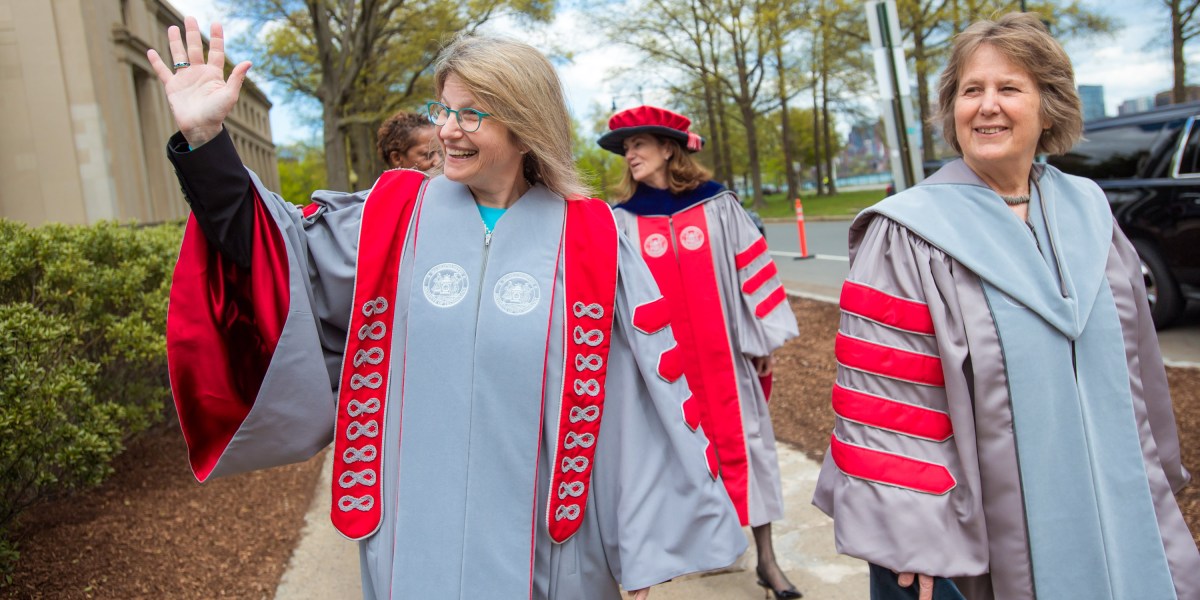When MIT met Sally

Lauding the Institute community’s “signature ability to foster the very best in fundamental research and harness it to confront society’s hardest problems,” Kornbluth noted that many of those challenges will require new research, new forms of collaboration, and renewed efforts to take timely action in society. “As humanity struggles with so many interlocking global crises, it has never needed the people of MIT more than it does now,” she said.
Envisioning MIT in 2033
Valerie Sheares Ashby, president of the University of Maryland at Baltimore County, introduced Kornbluth at the inauguration, praising her values, integrity, and leadership acumen. “She embodies exactly what higher education needs in leadership at this critical moment in the nation and the world: clarity, vision, courage, and humility,” said Sheares Ashby of her former colleague at Duke University, where Kornbluth served as provost. She called Kornbluth “a brilliant scientist, scholar, and teacher,” adding, “This is who she is every day.”
Kornbluth’s inaugural address, delivered after her formal investiture by MIT Corporation chair Diane Greene, SM ’78, and Presidents Emeriti Susan Hockfield and L. Rafael Reif, covered a range of topics, including the role of university leaders and the importance of improving the quality of life for students, developing campus staff, and supporting a diverse faculty. While she noted that it would be “arrogant in the extreme” to offer a detailed strategic vision while still in the midst of her campus-wide listening tour, she outlined an overall vision for MIT 10 years from now. It is reasonable to imagine, she said, that by 2033, Institute faculty and students will have “unraveled daunting intellectual puzzles, from mathematics to materials science, urban planning to economics, neuroscience to nuclear engineering, physics to philosophy to finance,” while also having “helped humanity come to grips with the tectonic forces of artificial intelligence, containing its risks and harnessing its power for good.”
“To meet the challenge of climate, it’s time for the people of MIT to engage in Rad Lab– level thinking and commitment again. I am absolutely certain that this urgent project is the singular effort that needs our shared attention. We can only meet this crisis if we’re brave enough to lower our shields, reach out, and work together in new ways.”
On top of that, she added, she envisions MIT having introduced a new core curriculum and experienced a “new flowering of the humanities and the arts,” which she called “the fields that tell us what it means, and why it matters, that we are human beings—fields that must be equal partners in inventing a just, humane, and equitable future.”
Kornbluth said she anticipates that by 2033 we will have witnessed new links between engineering and biology that will point to “the future of healing” and make Greater Boston “the hub of the next biotech revolution.” She spoke of MIT people using the power of entrepreneurship to “propel profound solutions out to communities around the world, from preventing pandemics to cleaning up plastic waste.” And she envisioned the Met Warehouse, future home of the School of Architecture and Planning and the Morningside Academy for Design, as “a bustling hub of making and design.”
But to genuinely be a success in 2033, said Kornbluth, MIT must make sure it “has truly become a place of inclusive excellence and enthusiastic diversity, where everyone feels that they matter, and they belong.”
Tackling the climate crisis
While Kornbluth cited many MIT endeavors, the subject she discussed at greatest length was climate change, which she called “the greatest scientific and societal challenge of this or any age.” On her campus listening tour, she said, members of the MIT community had “above all, and most urgently” expressed the need for the Institute to continue to “marshal a bold, tenacious response to the runaway crisis of climate change,” a line that received a healthy round of applause.
As she noted, MIT has played a key role in many landmark advances in science and technology previously, including the LIGO program that detected gravitational waves, the Human Genome Project, the Apollo program that put humans on the moon, and the Rad Lab, which helped develop radar during World War II.


